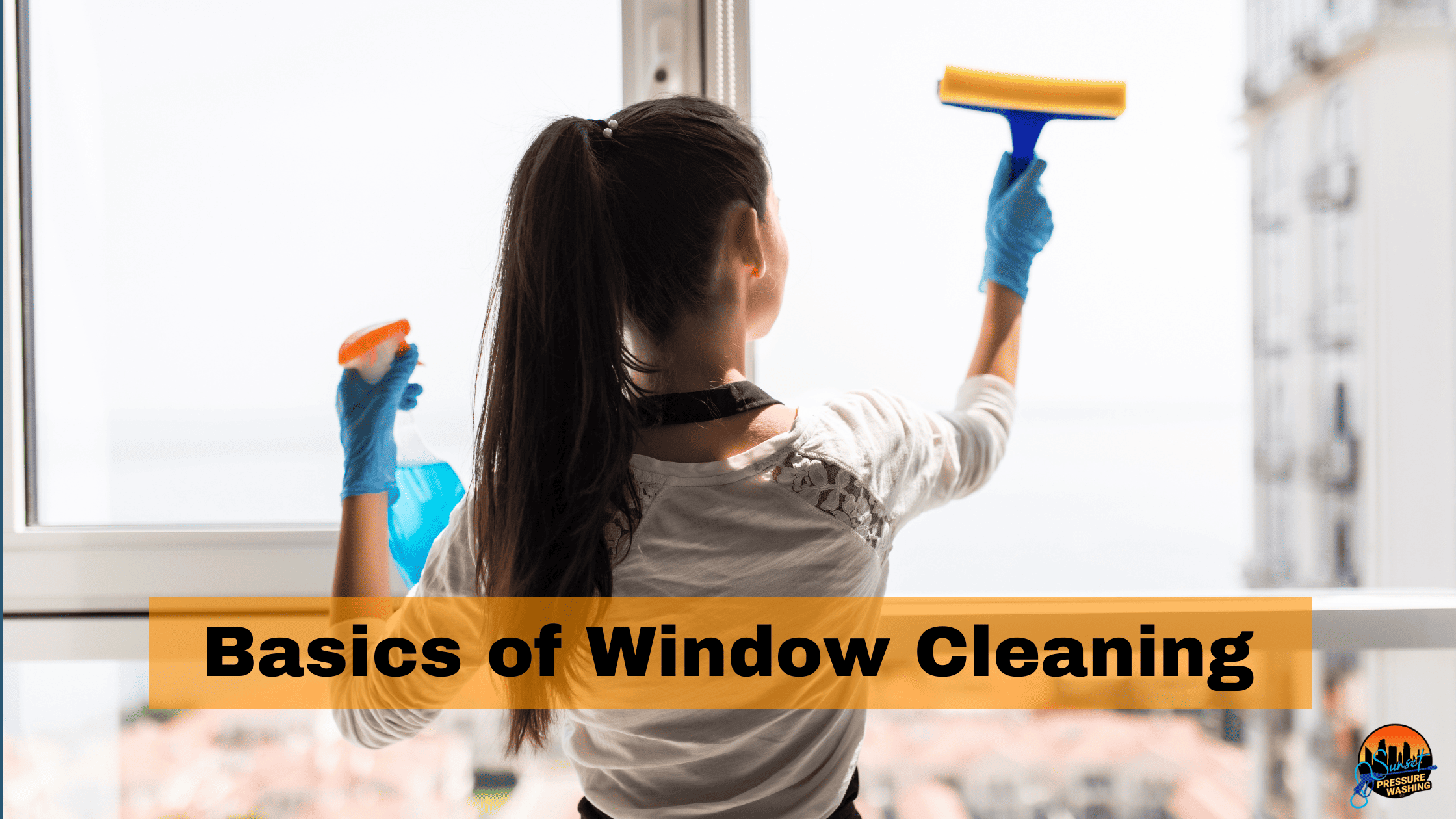
Basics of Window Cleaning
Window cleaning is a crucial aspect of home maintenance, ensuring not only clear views but also contributing to the longevity and efficiency of your windows. In this comprehensive guide, we’ll explore the fundamentals of window cleaning, providing you with expert tips and tricks to make your windows sparkle.
Introduction to Window Cleaning
Window cleaning is a vital aspect of home maintenance, offering more than just a clear view. It’s crucial for preserving the integrity and efficiency of your windows while enhancing your home’s overall appearance. Regular cleaning removes accumulated dust, dirt, and pollutants, preventing issues like reduced energy efficiency and potential damage to window frames and sills.
Beyond just the glass, window cleaning also involves caring for the frame, sill, and screens, protecting them from wear and tear, especially in harsh weather conditions. However, it’s important to note that different types of windows require specific cleaning methods to avoid damage, and cleaning windows in hard-to-reach places can pose safety risks. Regular window maintenance not only improves the look of your home but also extends the life and functionality of your windows.
Tools and Materials Needed for Window Cleaning
To achieve streak-free and sparkling windows, having the right tools and materials is essential. Here’s a list of the basic items you’ll need for effective window cleaning:
- Squeegee: The key tool for professional-looking results. A good squeegee has a sharp, smooth rubber blade to wipe the water off the glass without leaving streaks.
- Scrubber or Sponge: Used for applying the cleaning solution to the window. Scrubbers work well for larger windows, while a sponge may be sufficient for smaller panes.
- Bucket: A large bucket to mix your cleaning solution and to dip your scrubber or sponge into.
- Cleaning Solution: You can either purchase a commercial window cleaning solution or make your own. A popular homemade solution is a mixture of water with a small amount of dish soap.
- Microfiber Cloths: Perfect for wiping edges and drying windows after cleaning to avoid streaks. They are highly absorbent and leave no lint or residue.
- Ladder or Extension Pole: For reaching high windows. Safety is paramount, so ensure your ladder is stable and use caution.
- Rubber Gloves: To protect your hands, especially if you are using chemical cleaners.
- Scraper or Razor Blade: Useful for removing stubborn substances like tree sap or bird droppings. Be careful to use it correctly to avoid scratching the glass.
- Water Hose (Optional): For pre-rinsing exterior windows, especially if they are very dirty.
- Chamois or Dry Cloth: For a final wipe-down, leaving a shine without streaks.
Safety First in Window Cleaning
When it comes to window cleaning, safety should always be your top priority, especially when working with ladders or cleaning high windows. Here are some key safety tips to keep in mind:
Ladder Safety
- Choose the right ladder for the job. It should be sturdy and tall enough to comfortably reach your windows.
- Place the ladder on a stable, even surface. Avoid placing it on uneven ground or slippery surfaces.
- Always maintain three points of contact (two hands and one foot or two feet and one hand) when climbing or descending a ladder.
- Never overreach while on a ladder. Move the ladder instead of stretching to reach distant spots.
Protective Gear
- Wear non-slip shoes, especially when using a ladder or when cleaning windows from a height.
- Consider using safety glasses and gloves, especially if you’re using chemical cleaners.
Chemical Safety
- Read and follow the instructions on any commercial cleaning products.
- Ensure good ventilation when using chemical cleaners, particularly indoors.
Awareness of Surroundings
- Be aware of your surroundings, especially when moving ladders around or extending long poles.
- Keep pets and children away from the area where you are working.
Avoid Electrical Hazards
- Be cautious of overhead power lines when using ladders or long tools.
- Avoid using water or liquid cleaners near electrical fixtures.
Proper Handling of Tools
- Ensure that your tools, especially scrapers or blades, are used correctly and stored safely when not in use.
Knowing Your Limits
- If a window is too high or in a position that seems risky to reach, it’s better to call in professional window cleaners.
- Don’t take risks with your safety for the sake of clean windows.
Techniques for Different Types of Windows
Cleaning windows effectively often depends on the type of window you’re dealing with. Each style has its unique characteristics and therefore requires specific techniques for optimal cleaning. Here’s a guide to handling different types of windows:
Sliding Windows
- Slide the window open and clean the exterior surface from inside your home if possible.
- For the tracks, use a brush to loosen dirt and a vacuum to remove debris. Wipe down with a damp cloth.
Double-Hung Windows
- These windows allow you to clean both the inside and outside from within your home. Tilt the sash in and clean each side with your solution and squeegee.
- Clean the tracks and frames with a brush or a damp cloth.
Casement Windows
- These windows allow you to clean both the inside and outside from within your home. Tilt the sash in and clean each side with your solution and squeegee.
- Clean the tracks and frames with a brush or a damp cloth.
Bay and Bow Windows
- Due to their shape, these windows might require you to clean from the outside.
- Be careful with ladder placement and reach, and consider using a long-handled squeegee.
Stained Glass Windows
- Use a gentle solution, as harsh chemicals can damage the lead or the glass.
- A soft cloth or a brush with soft bristles is ideal for cleaning.
Tinted Windows
- Avoid ammonia-based cleaning products as they can damage the film.
- Use a mild soap solution and a soft cloth or squeegee.
Skylights
- Skylights require you to clean from the roof, so safety is a primary concern.
- Use an extension pole for hard-to-reach skylights.
French Windows and Doors
- Clean each pane individually with a squeegee that fits the size of the panes.
- Wipe down frames and seals to prevent water accumulation.
Effective Cleaning Solutions for Window Cleaning
The choice of cleaning solution is crucial in achieving sparkling, streak-free windows. While there are many commercial cleaners available, you can also make effective solutions at home. Here’s a look at both options:
Commercial Cleaning Solutions
- These are specifically formulated for window cleaning and can effectively cut through grease and grime.
- Look for solutions that are ammonia-free, especially if you have tinted or treated windows, as ammonia can damage certain types of glass and window films.
Homemade Cleaning Solutions
- A popular DIY solution is a mixture of water and white vinegar. The acidic composition of vinegar helps break down the filmy residue that often accumulates on window panes.
- Another effective mixture is water with a few drops of dish soap. This solution is gentle yet effective in lifting dirt and grease.
- For tougher stains, rubbing alcohol or ammonia can be added to the solution, but use these sparingly and ensure good ventilation.
Tips for Using Cleaning Solutions
- Always start by dusting or dry brushing the window to remove any loose dirt or cobwebs.
- Use a soft sponge or cloth to apply the solution to avoid scratching the glass.
- Avoid cleaning windows in direct sunlight. The heat can cause the solution to dry too quickly, leaving streaks.
Eco-Friendly Solutions
- For an environmentally friendly approach, consider solutions using lemon juice or baking soda, which are natural and biodegradable.
- Using distilled or deionized water can reduce streaking, especially in areas with hard tap water.
Precautions
- Test any new solution on a small area of the window first to ensure it doesn’t cause any damage.
- Label homemade solutions clearly, especially if you’re storing them for later use.
10 Streak-Free Cleaning Methods for Windows
Achieving streak-free windows can be challenging, but with the right techniques, it’s definitely attainable. Here are some methods and tips to ensure your windows are left sparkling clean without unsightly streaks:
1. Choose the Right Time
Avoid cleaning windows in direct sunlight. The sun can cause the cleaning solution to dry too quickly, leaving streaks.
2. Use the Right Tools
A squeegee is more effective than cloth for streak-free results. Use a new or well-maintained squeegee with a sharp, smooth rubber blade.
3. Proper Technique with a Squeegee
Start at the top corner of the window and pull the squeegee down in a straight stroke.Wipe the squeegee blade with a clean cloth after each stroke. Overlap each stroke slightly and work your way across the window.
4. Use Microfiber Cloths
If using cloths, microfiber is the best option as it doesn’t leave lint or residue. Use a clean, dry microfiber cloth to wipe off any remaining solution.
5. Buff Away Streaks
After cleaning, if any streaks remain, buff them out with a clean, dry microfiber cloth or a chamois.
6. Cleaning Solution Application
Don’t over wet the window. A light spray or application of cleaning solution is sufficient.
7. Regular Cleaning
Regularly cleaning your windows prevents the buildup of grime, making it easier to avoid streaks in the future.
8. Detailing the Edges
Use a damp, wrung-out cloth to clean the edges of the window. This helps remove any cleaner that might have pooled in these areas.
9. DIY Cleaning Solutions
If using a homemade cleaning solution, ensure it’s mixed correctly. Too much soap can leave a film, resulting in streaks.
10. Rinse with Clear Water (If Needed)
In case of heavy dirt or if using a soap-heavy solution, a final rinse with clear water can help prevent streaks.
Dealing with Common Window Cleaning Challenges
Window cleaning can present various challenges, from stubborn stains to hard-to-reach areas. Here are strategies to overcome some common difficulties:
Hard Water Stains
- Use a solution of white vinegar and water. Vinegar’s acidity helps break down mineral deposits.
- For tougher stains, use a commercial hard water stain remover, following the manufacturer’s instructions.
Bird Droppings
- Soak the area with water and let it sit for a few minutes to soften the droppings.
- Gently scrape off the droppings with a plastic scraper or a cloth, being careful not to scratch the glass.
Sticky Substances (like Tree Sap)
- Apply a small amount of rubbing alcohol or mineral spirits to a cloth and gently rub the area.
- Rinse the window thoroughly with water after the sap is removed.
Paint Splatters
- Use a razor blade or scraper, but ensure the window is wet to avoid scratches.
- Scrape gently at a 45-degree angle.
Cleaning Window Screens
Dealing with High and Hard-to-Reach Windows
Dealing with High and Hard-to-Reach Windows
- Use an extension pole with a squeegee or a sponge attachment.
- For safety, consider hiring professionals for very high windows.
Dirty Window Tracks
- Vacuum the tracks first to remove loose dirt and debris.
- Use a mixture of baking soda and vinegar to loosen grime, then scrub with a toothbrush or a small brush.
Condensation and Mold
- Regularly wipe down windows to prevent moisture buildup.
- For mold, use a solution of bleach and water (be cautious with the use of bleach, ensuring good ventilation).
Streaks After Cleaning
- Buff the window with a clean, dry microfiber cloth.
- Review your cleaning technique and ensure you’re not using too much soap or cleaning in direct sunlight.
Seasonal Challenges
- In colder months, use lukewarm water to prevent freezing.
- In hot weather, clean windows early in the morning to avoid quick drying and streaks.
Maintenance Between Cleanings for Windows
Regular maintenance is key to keeping your windows in top condition and extending the time between deep cleanings. Here are some tips to help you maintain your windows:
Regular Dusting
Use a microfiber cloth or a soft brush to dust the window frames, sills, and glass weekly. This prevents the build-up of dirt and grime.
Spot Cleaning
Address fingerprints or small marks immediately using a clean, damp cloth. This prevents spots from becoming more stubborn over time.
Check and Clean Window Tracks
Regularly check the tracks for dirt or debris. A quick vacuum or wipe with a damp cloth can prevent build-up.
Inspect for Damages
Regularly inspect your windows for any signs of damage, such as cracks, chips, or malfunctioning parts. Early detection can prevent bigger issues.
Clean Window Screens
Gently brush or vacuum the screens occasionally to remove dust and dirt. This helps improve air quality and window clarity.
Avoid Harsh Chemicals
For regular maintenance, avoid using harsh chemicals as they can degrade the window seals and frames over time.
Protect from Direct Sunlight
Use blinds or curtains during peak sunlight hours to protect windows from excessive heat and UV exposure, which can lead to fading and degradation.
Manage Moisture:
In areas with high humidity, use a dehumidifier or ensure proper ventilation to prevent condensation and mold growth on the windows.
Lubricate Moving Parts
Periodically lubricate the moving parts of windows, such as hinges and tracks, to ensure smooth operation.
Seasonal Checks
Before extreme weather seasons (like winter or monsoon), check and prepare your windows to handle the conditions. This might include sealing gaps or checking for proper drainage.
When to Call in the Professionals for Window Cleaning
While regular maintenance and cleaning can be handled independently, there are situations where it’s best to call in professional window cleaners. Understanding when to seek their help can save you time and ensure the job is done safely and effectively. Here are scenarios where professional assistance is recommended:
1. High or Hard-to-Reach Windows
If your windows are located high up or in difficult-to-reach areas, it’s safer to have professionals clean them. They have the necessary equipment and expertise to do the job without risking injury.
2. Post-Construction Cleaning
After construction or major renovations, windows often require a thorough cleaning to remove paint, plaster, or construction debris. Professionals can handle this efficiently without damaging the glass.
3. Stubborn Stains and Build-Up
If you’re dealing with stubborn stains like hard water marks, mineral deposits, or oxidation, professional cleaners can effectively remove these using specialized products and techniques.
4. When Time is a Constraint
If you have a busy schedule and lack the time to clean your windows thoroughly, hiring professionals can be a convenient solution.
5. For Special Types of Windows
Certain windows, like stained glass or windows with special coatings, require specialized cleaning methods. Professional window cleaners will have the right tools and knowledge to clean these windows properly.
6. Before Major Events
If you’re hosting a significant event at your home or business and want your windows to be in pristine condition, professional cleaners can ensure a thorough job.
7. Regular Scheduled Cleanings
If you’re hosting a significant event at your home or business and want your windows to be in pristine condition, professional cleaners can ensure a thorough job.
8. When Quality is a Priority
For superior results, especially where aesthetics are crucial, professionals can achieve a level of cleanliness that might be hard to replicate on your own.
9. If You’re Unsure About Safety
If you have any doubts about your ability to clean your windows safely, it’s best to leave it to the professionals.
10. For Comprehensive Cleaning
Professional window cleaners often provide comprehensive services, including cleaning frames, sills, and tracks, offering a level of detail that goes beyond just cleaning the glass.
Elevate Your Window Cleaning with Sunset Pressure Washing
Sunset Pressure Washing’s expertise in basics of window cleaning extends beyond just the surface, addressing the intricacies of different glass types and building structures. Our holistic approach ensures a streak-free finish, enhancing the natural light and ambiance of your interior spaces.
Our commitment to customer satisfaction and ecological practices makes them a top choice for those looking to combine aesthetic improvements with environmental responsibility. Discover the difference a professional touch can make to the clarity and lifespan of your windows by exploring their specialized window cleaning services.






